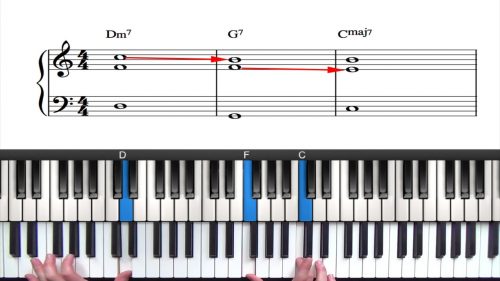Relative Major & Minor Keys
This lesson delves into the intricate relationship between relative major and minor keys. We set the foundation for arranging the tune "Autumn Leaves" by developing an understanding of the harmonic framework of the tune.
The Relative Major & Minor Relationship
Understanding the relationship between relative major and minor keys is important for analysing the harmony and structure of jazz standards. So far in this course we have explored the key of Bb major and we will now identify the relative minor key – G minor. The G natural minor scale shares the exact same notes as the Bb major scale, but starts and ends on the note G.
The Bb major scale creates a happy and cheerful vibe and in contrast, the G minor scale carries sad and somber tone; despite sharing the exact same notes. It’s common for jazz standards to include 251 progressions in both the major and relative minor key and this distinction is vital for understanding the harmonic framework of "Autumn Leaves".
"Autumn Leaves" Harmonic Analysis & Form
"Autumn Leaves" is an exemplary model for studying the shift between relative major and minor keys within jazz standards. The tune follows an AABC form and the A sections starts with a 2-5-1 in Bb major closely followed by a 2-5-1 in G minor. The B section then flips this order, starting with the minor progression and the the major progression. The C section presents different harmony which we will cover in the next lessons of this course.
The Key Of "Autumn Leaves"
Initially, you might expect "Autumn Leaves" to be in the key of Bb major due the song starting with a 251 in Bb major . However, a closer examination of the chord progressions, especially the final chord Gmin7, indicates the song’s true key: G minor. Our analysis underscores the duality of the songs harmony; weaving between the brightness of Bb major and the melancholy of G minor.
Practice Tips
-
Understand the Major-Minor Relationship: Grasp the connection between relative major and minor scales to better anticipate harmonic shifts. Modulating from the major key to the relative minor key (and vice versa) is a common feature of jazz standard harmony.
-
Master Three-Note Voicings: Arrange the harmony with 2-handed spread voicings to clearly visualise the voice leading in the 251 progressions. Once you have completed these Novice lessons, you can move onto the more advanced "Autumn Leaves" lessons on the PianoGroove website.
- Memorise the Form: Learn and memorise the form (AABC) of "Autumn Leaves" to understand how the song is structured and divided into 4 distinctly marked sections. Clearly visualise where you are in the form as you play through the song.






